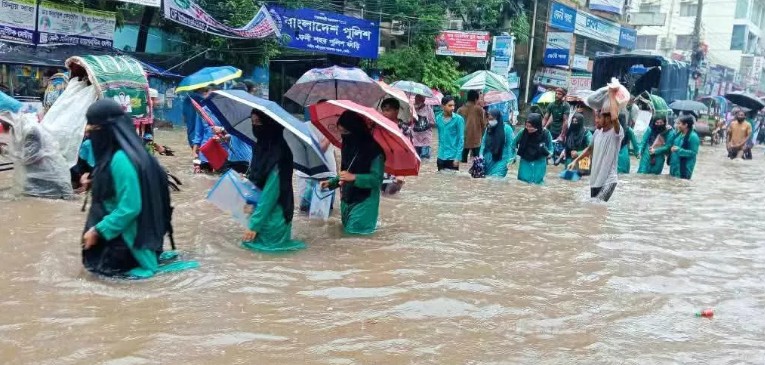More than one hundred villages in Feni have been submerged following a sudden and devastating flood that struck the district’s three upazilas—Fulgazi, Parshuram, and Chhagalnaiya—leaving nearly a lakh people stranded. Bangladesh army, red crescent society and scout volunteers and fire service personnel have launched a full-scale rescue operation.
Heavy rain and upstream water from India, the Muhuri, Kahua, and Silonia rivers swelled rapidly, breaching their embankments at dozens of points and inundating vast swathes of low-lying land. The Muhuri River alone was flowing 86 centimetres above the danger level at its peak, according to the Water Development Board engineers.
Officials said more than 40 villages in Fulgazi were completely underwater. Many homes have submerged up to their roofs and entire neighbourhoods disconnected from road networks. In Parshuram, more than 45 villages were affected, while Chhagalnaiya also saw several communities cut off from essential services. Roads, ponds, croplands, schools, and health centres were all submerged in many areas, with livestock and food stocks washed away in some places.
Feni’s Deputy Commissioner Musammat Shahina Akhter said the district administration had been coordinating a multi-agency emergency response since the floodwaters began to rise early Wednesday. The Bangladesh Army was deployed by midday to assist with rescue operations, particularly in areas where local volunteers were unable to reach stranded residents due to strong currents and damaged embankments. Speed boats and helicopters were used to ferry out those trapped inside homes or marooned on rooftops. The Inter-Services Public Relations (ISPR) Directorate confirmed in a statement that the military had focused on the twin upazilas of Fulgazi and Parshuram, where the situation was described as “critical and rapidly deteriorating”.
Fire Service and Civil Defence personnel also joined rescue missions, operating alongside local Red Crescent volunteers, scouts, and youth organisations. By nightfall, at least 300 people had been rescued using small boats and improvised rafts, though officials cautioned that many more remained in need of urgent evacuation.
Communication breakdowns hampered coordination in several unions as mobile phone networks failed and power supply was disrupted. In response, amateur radio operators—known as ‘hams’—stepped in to establish emergency communication lines. Their coordination helped facilitate more than 375 individual rescue operations during the first four days of flooding, according to emergency responders.
To accommodate displaced families, 78 temporary shelters were opened by the district administration, housing approximately 1,600 people by Thursday morning. Union Parishad chairmen reported that hundreds more were staying with relatives or seeking refuge in local schools and religious centres. Relief materials, including dry food, bottled water, and basic medical supplies, were distributed to affected families, although demand far exceeded available resources in some areas.
Upazila Nirbahi Officers (UNOs) in both Fulgazi and Parshuram confirmed that each upazila had around 50 tonnes of rice allocated for relief distribution and that more than 500 food packets had been delivered as of Thursday evening. Volunteers from the Bangladesh Red Crescent Society were seen handing out cooked meals and providing hygiene kits in makeshift shelters.
Several non-governmental organisations, including Friendship and BRAC, also launched humanitarian efforts. Friendship’s mobile medical units treated more than 120 patients on the first day of deployment and distributed over 11,000 litres of purified water using their mobile treatment plants. Hygiene kits, women’s dignity packs, and ready-to-eat meals were also supplied in coordination with the local administration.
Feni’s meteorological office recorded 97 millimetres of rainfall over a 24-hour period, but officials noted that the flood was made significantly worse by upstream river swelling in Tripura, India. Cracks in embankments had first appeared in early July, with repairs delayed due to budget constraints and waterlogging. Residents in affected areas said the authorities failed to reinforce key embankment points despite warnings from locals. “We saw this coming. They did patchwork on the Muhuri barrage, but it collapsed again just a week later,” said Sulaiman Hazari, a resident of South Ghuniya.
Estimates of the economic loss are still being compiled, but local officials said preliminary assessments suggest damage to crops, homes, and public infrastructure could exceed Tk 30 crore. Several fish farms and livestock enclosures have been wiped out, and local traders fear months of economic disruption due to road damage and supply chain breakdowns.
Although the water level began to recede in some areas by Thursday night, the forecast remains uncertain. Disaster response officials warned of possible further flooding if rainfall in the upstream regions of India continues. Emergency surveillance of embankments and sluice gates remains active.
As Feni continues to reel from one of its worst flooding episodes in recent memory, rescue operations are ongoing, and officials say long-term rehabilitation will require significant resources and sustained intervention.
“We may be past the worst, but we are not out of danger yet,” said Deputy Commissioner Shahina Akhter. “Our priority is to ensure no lives are lost in the aftermath.”
If rainfall continues over the weekend, authorities may expand shelter capacity and seek additional food and relief allocations from the Ministry of Disaster Management and Relief. Meanwhile, affected families await clean water, medicines, and a safe return to normalcy.


